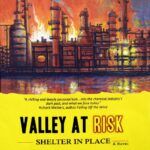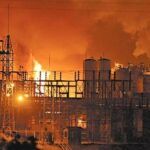Press Release; November 26, 2014
Valley at Risk: Shelter in Place
New novel about explosion at Bhopal “sister plant” in the US
In August 2008 an enormous explosion in a BAYER pesticide plant rocked an area west of Charleston, hurling a fireball hundreds of feet into the air and killing two workers. The Kanawha Valley only narrowly escaped a chemical plant catastrophe, according to a report released by congressional investigators. Committee investigators found that the explosion „came dangerously close“ to compromising an MIC storage tank 80 feet away. Had the residue treater hit the tank, „the consequences could have eclipsed the 1984 disaster in Bhopal/India.“
In the 1980s, the factory at Institute/WV belonged to Union Carbide and was regarded as the „sister plant“ to the factory in Bhopal where in December 1984 thirty tons of MIC leaked and at least 15,000 people died.
For many years activists from West Virginia and the Coalition against Bayer Dangers (based in Germany) demanded to dismantle the MIC tanks at Institute – without success. When the Coalition spoke up on the issue four months before the explosion at the BAYER shareholder meeting, CEO Werner Wenning rejected any need for action. The plant allegedly conformed to the „latest safety standards“ and had an „excellent incident rate“.
Now West Virginia author Dwight Harshbarger has published the 312-page novel Valley at Risk: Shelter in Place, a fictionalized account of the fatal explosion at Institute. The book describes communities in the shadow of chemical plants where leaks, spills and overheating boilers could spell catastrophe.
Bill Reger-Nash, a professor at West Virginia University’s School of Public Health, stated, “Using vigorous research and profound insights, Dwight Harshbarger tells what is happening in neighborhoods throughout America. Avaricious short-term return-on-investment strategies place hundred of thousands of people in peril.” Harshbarger lives in Morgantown today, where he is an adjunct professor at the WVU School of Public Health.
More Info: Bayer Institute Campaign, book Valley at Risk
“Excellent! Excellent! Excellent! This is a beautiful and engrossing story featuring rich, complex characters and a dynamic plot that had me eagerly waiting to turn the next page.” – Eliot Parker, author of Breakdown at Clear River and Making Arrangements
“. . . the characters come alive . . . the threat is palpable . . . a ride that will enlighten the reader.” – Joseph Wyatt, Professor Emeritus, Marshall University, author of The Millenium Man
„Progress can be an illusion, as Dwight Harshbarger‚s compelling novel about a West Virginia chemical-plant disaster shows us. While some gain, others lose—profoundly. Harshbarger deftly charts the lives of a small town‘s winners and losers, and brings us a protagonist who, though caught in the middle, is determined to uncover the truth.“ – Mark Brazaitis, author of Julia & Rodrigo
Charleston Gazette, November 19, 2014
Harshbarger to visit Taylor Books to sign new novel
West Virginia author Dwight Harshbarger has just published a new novel about people living near chemical plants that generate leaks and spills that threaten lives and safety in local communities.
Harshbarger will visit Taylor Books, at 226 Capitol St. in downtown Charleston, to talk about and sign copies of his new book Saturday between 3 p.m. and 7 p.m.
“Valley At Risk: Shelter in Place” is set in a mythical town called Jackson, in Vandalia Valley, in West Virginia.
The novel follows Julie Brown, an investigative reporter working to expose the facts behind a chemical plant explosion that killed two people and could have killed hundreds more.
A synopsis of the new book, provided by Mid-Atlantic Highlands, a publisher in Huntington, states: “Late on a hot night in August 2008, the pesticide unit of the Kabot Agronomy chemical plant explodes.
“The plant, formerly owned by Union Carbide, uses highly toxic MIC (methyl isocyanate) in pesticide production. An hour after the explosion, widespread fear of a MIC gas release triggers a valley-wide shelter-in-place….
“In 1984, at the Union Carbide plant in Bhopal, India, a twin sister to the local plant now owned by Kabot, a release of toxic MIC killed thousands of residents,” the synopsis added.
Some estimate up to 8,000 people died from gas-related injuries and diseases from the Bhopal explosion, while many thousands more were hurt.
A similar incident, much less devastating than the fictional Bhopal explosion, took place locally.
At Bayer CropScience’s plant in Institute, an explosion and fire involving MIC killed two local workers on August 28, 2008. A year later, Bayer announced it was eliminating 80 percent of its huge MIC stockpile.
Bill Reger-Nash, a professor at West Virginia University’s School of Public Health, stated, “Using vigorous research and profound insights, Dwight Harshbarger tells what is happening in neighborhoods throughout America. Avaricious short-term return-on-investment strategies place hundred of thousands of people in peril.”
Harshbarger lives in Morgantown today, where he is an adjunct professor at the WVU School of Public Health.
In 2011, he won the West Virginia Library Association’s Award of Literary Merit for his earlier novel, “Witness at Hawks Nest.”
That novel, published in 2009, focuses on the 21-month project from March 1930 to December 1931 to build a tunnel and an accompanying dam at Hawk’s Nest along the New River near Gauley Bridge.
The tunnel was built to divert the New River’s rapidly-flowing waters to generate electricity for a nearby metal-processing plant in Alloy, long operated by Elkem Metals.
The rock in Hawks Nest Tunnel was rich in silica, whose dust create deadly lung disease.
In 1986, Yale University Prof. Martin Cherniak published “The Hawk’s Nest Incident: America’s Worst Industrial Disaster.” The book focused on the 1,213 men who worked inside the tunnel for at least two months, which Cherniak believed was the minimum exposure needed to contract silicosis.
Of those 1,213 workers, at least 764, or 63 percent of them, died within five years of the tunnel’s completion. Cherniak’s statistical assumptions were conservative, so the actual death rate was probably higher.
“I have known about the tunnel since I was a child,” Harshbarger said during an interview with the Sunday Gazette-Mail in 2009.
“Back in the 1970s, when I was teaching at West Virginia University, I really began to become aware of what happened.
“In the late 1970s, I was director of community mental health center in Beckley. That brought me into direct contact with people who knew about the tunnel. I was so moved at what happened there and I still am.”
Both novels focus on the feelings of a wide variety of people, including: workers on the industrial projects, their wives, girlfriends, children, other friends, company guards, company officers, local restaurant and business owners, police officers and West Virginia state safety inspectors.
Harshbarger also visited Taylor Books in August 2009 to promote his earlier book.
Harshbarger earned B.A. and M.A. degrees in psychology at WVU and a PhD. in psychology at the University of North Dakota. By Paul J. Nyden

